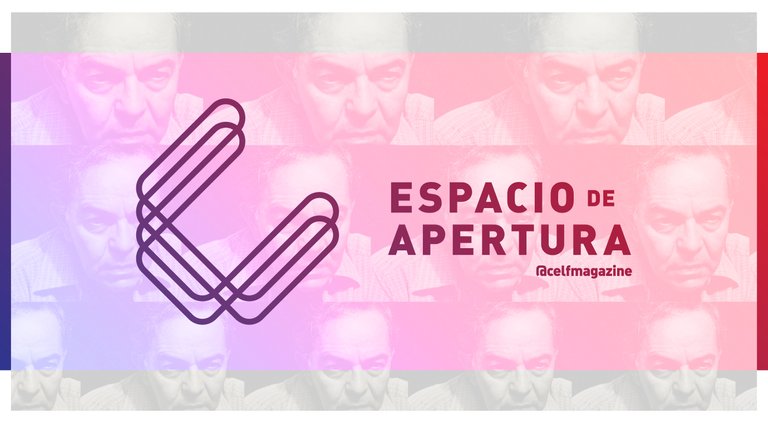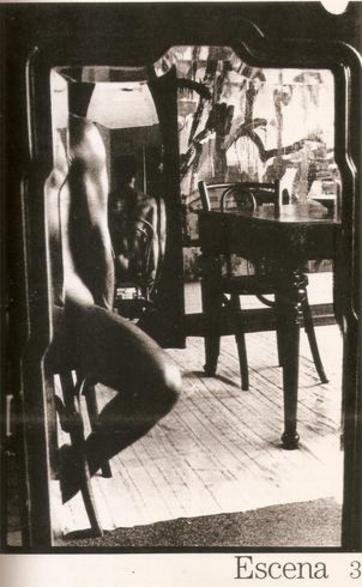
Part I
*****
Indeed, photography will have a fundamental importance in Chocrón's theatrical work, as well as illumination, which will act to demarcate the scenes, certain temporal transits and narratives, and will also aesthetically semantize the dramatic action. So, for example, each scene will close with a black fade, fulfilling a syntactic and semantic function, as in the cinematographic montage. The scenes come out of the black as if they will be developed photographically, or sometimes seem to "freeze" as in a photograph. We could even postulate a relationship between the unique and closed character of the scenographic space and photography, as a homogeneous, "frozen", framed space..
This protagonist character of photography is fully justified in the work: the presence of the photographer, Luis, a character who unleashes Saúl's existential search, and who has to permeate all history and discourse. This also justifies, as a paratextual and extratextual element, the dedication of the work to the memory of Luis Salmerón, who was a renowned Venezuelan photographer, who died of AIDS in 1991, a person with whom Chocrón maintained a very close affective relationship. This reference exposes the autobiographical character of the work..
Similarly, photography has an impact on another dramatic unit: time. The dramatic action occurs in the present to the point that it is present of the spoken word, of the dialogue, through which history is accessed. In Written and sealed will be presented the history of Saul, which will occur in a time mostly present, the time of staying in Albuquerque and the encounter with Miguel. The time of history (the time of the events) will be broader than the time of the discourse (the time used to tell that one), but this, through ellipses, will reduce it to the previous one, or delay it through retrospectives, which will be basically memories of Saul. History will be demarcated by a real time period, that between the winter and spring seasons. The first part of the work corresponds to winter; the second part to spring. Saul arrives in Albuquerque in winter, and leaves that city to return to Caracas in spring. This seasonal lapse, in addition to being a precise temporal reference, also involves a metaphorical sense of the process of death and rebirth that Saul will live particularly; but also the other characters will experience the inner personal change symbolized by spring. This spiritual modification is noticed by Carmen, at the beginning of the second part, in scene 5: "Now, seeing spring day by day, I am certain that there is a God. Too bad Luisín could not see it!...".

edited by the Centro Cultural Consolidado.
It can be said that there is an interaction of times: the present requires the past; the past is called by and from the present, which it illuminates; the present is conditioned by the past, in other words, it is a question of solving a present problem taking into account the past. The past has its entrance in the discourse through the intervention of Luis, who is dead, and death is timeless: "What happens is that I am in your house in Caracas, working. Long before now, of course. Collapse of times. Advantage of death," Luis tells Saúl. The character acts in the present tense of the story by the force of memory and affection, but also as a ghostly presence justified by death. The condition of eternity, of permanence in time, of fixity, which is death, is analogous to photography. In one of its dialogues it can be read:
Saul: (...) That's the wonder of a photograph. It's there: forever stationary.
Nancy: As if time didn't pass.
Saul: Photographs are the same as death: they freeze time forever.
Luis: No sadness, Saulito, please.
Saul: I don't say it with sadness. It has just occurred to me that every photograph will always be the same…
The rhythm of the internal temporality of the work, that is, its duration, seems to be marked by a slow tempo, the one that makes the experience; and this can be a privileged form of correspondence with the music that governs the spectacular text: the force of the adagio cantábile (see previous post, where the link was placed to listen to the indicated musical piece).
As can be deduced from what has been said so far, the story of Written and Sealed has in Saul his cardinal character; in him the central conflict of the drama will develop. But around him will be nucleated other characters who, from different experiences and visions, even in apparent opposition to that, will contribute to the fulfillment of the transformation of Saul and themselves, or their own reaffirmation.
Saul is marked by the recent death of Luis, a close friend with whom he maintained a teacher-student relationship and who was part of his "chosen family". He is of Jewish origin, but his attitude is one of disbelief and uncertainty. His verb and psychology feed on an irony and a caustic humour, which will make him behave in a hard and often clumsy way. His trip to Albuquerque, to escape the pain caused by Luis' physical disappearance, will confront him with his fears and ignorance. The encounter with his old friend Miguel, now a Catholic priest, will unleash within him the conflict of his life, the dilemma of disbelief-faith.

Luis returns and joins everyone's life through the vigour of affection and sorrow. With his vitality and freshness, he will sting the behavior and relationships of the group. He will be the main catalyst for the changes that take place. His art, photography, will encourage reflection on the meaning of life and death, on the purpose of art itself.
In the company of Miguel and under his unconfessed guidance, Saúl will assume his journey as a retreat and a quest. He will recognize the need for his sacrifice and death in order to be born to his new life. Just as God revealed Himself to Saul, an unbeliever and persecutor, and thus became Paul, so Saul, in this confrontation with remembrance, friendship and coexistence with the mystery of the place, will be revealed to him the sense of faith, of God, in finding himself. Saul will redeem the meaning of the Jewish covenant of faith in friendship and life: "Written and sealed. He will be reconciled with joy and community, and will undertake the return journey as the mythical hero.
In short, the central conflict of written and sealed will be that of disbelief-faith tension, but around this, matching it, other problematic issues will be evident: the fear of illness and death, the meaning of life, the teacher-student relationship, the love-friendship relationship, the reason for art, the relationship between theatre and life, among the most outstanding.
TRANSCENDENCE THROUGH ART

At the end of the last scene is what may be the great conclusion of this work: the reason of art. In this scene, in the parliament in which Saul declares his admiration for the strength and energy of the place, he exclaims: "Everything here looks eternal. It is eternal," and highlights the divine workmanship of such a work of nature. In the dialogue of the same scene one reads:
Luis: (...) Do you know what my eternal life could be? Being a character. Not a person who dies but a character like those of the theater. I would like to be a character, who will always live because it has been told.
Miguel: Luis is a character. I'd like to be me anyway.
Saúl: You already are. Lucky for all of us who become characters.
Luis and Miguel, characters from the book Written and sealed, want to be characters to become eternal, and they already are. Their existence is that of characters created for durability in an artistic work. They have passed from the transitory life to the one that transcends time: they are there forever, by the hand of that little demiurge who is the artist.
In a self-reflective and metafictional game, the theatre looks at itself and reveals its artistic face. It is conceived and advocated as a form of transcendence of life, a way of being made for permanence, just like photography.
Here the autobiographical character of the work reaches its highest expression. Isaac Chocrón, playwright, creator of this work, assumes Saúl's voice to recognize himself in his art and in his own creation. Life affected by the pain of a friend's death, death itself, even the hard work of a teacher and writer, is transcended in theatre. Isaac-Saul also desires character, and already is.
Bibliographic reference
Chocrón, I. (1993). Escrito y sellado. Caracas: Ex Libris.
Writed by @josemalavem
This post is a translation of its original Spanish version, and represents an UPDATE for our Crowdfounding Fundition Campaign.
Building trust in a multi-language community
In order to receive upvotes funding from @fundition, and sponsors who wish to join our project, we will translate the editorial content as updates for our crowdfunding fundition campaign.
As the project gets underway and develops, we will seek, as far as possible, to work hand in hand with the English-speaking community, as we understand that our value proposition crosses the language barrier and should not be limited by it.
Learn more about @celfmagazine and @celfditorial:
 |
 |
 |
 |
|---|
Join our community
Congratulations @celfditorial! You have completed the following achievement on the Steem blockchain and have been rewarded with new badge(s) :
You can view your badges on your Steem Board and compare to others on the Steem Ranking
If you no longer want to receive notifications, reply to this comment with the word
STOPTo support your work, I also upvoted your post!
Vote for @Steemitboard as a witness to get one more award and increased upvotes!